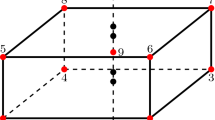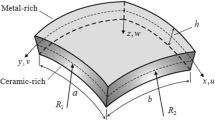Abstract
In this work, a shear locking-free three-node shell element based on Mindlin–Reissner theory is presented for a nonlinear dynamic analysis including sheet metal forming. In the present formulation, only displacement and rotational degrees of freedom are utilized, and the discrete shear gap of each field node is deduced using rotations of all three field nodes in a local coordinate system by the integral from the fictitious central point to the corresponding field node, which makes it alleviate the shear locking phenomenon. In order to validate the availability in solving nonlinear dynamic problems, several benchmark problems and sheet metal forming applications are employed. The results show potentiality in application to practical problems because of the simple implementation.





























Similar content being viewed by others
References
Phung-Van, P., Nguyen, L.B., Tran, L.V., Dinh, T.D., Thai, C.H., Bordas, S.P.A., Abdel-Wahab, M., Nguyen-Xuan, H.: An efficient computational approach for control of nonlinear transient responses of smart piezoelectric composite plates. Int. J. Non Linear Mech. (2015). https://doi.org/10.1016/j.ijnonlinmec.2015.06.003
Phung-Van, P., Tran, L.V., Ferreira, A.J.M., Nguyen-Xuan, H., Abdel-Wahab, M.: Nonlinear transient isogeometric analysis of smart piezoelectric functionally graded material plates based on generalized shear deformation theory under thermo-electro-mechanical loads. Nonlinear Dyn. (2017). https://doi.org/10.1007/s11071-016-3085-6
Valizadeh, N., Natarajan, S., Gonzalez-Estrada, O.A., Rabczuk, T., Bui, T.Q., Bordas, S.P.A.: NURBS-based finite element analysis of functionally graded plates: static bending, vibration, buckling and flutter. Compos. Struct. (2013). https://doi.org/10.1016/j.compstruct.2012.11.008
Pagani, M., Reese, S., Perego, U.: Computationally efficient explicit nonlinear analyses using reduced integration-based solid-shell finite elements. Comput. Methods Appl. Mech. Eng. (2014). https://doi.org/10.1016/j.cma.2013.09.005
Cai, Y., Cui, X., Li, G., Liu, W.: A parallel finite element procedure for contact-impact problems using edge-based smooth triangular element and GPU. Comput. Phys. Commun. (2018). https://doi.org/10.1016/j.cpc.2017.12.006
Sydenstricker, R.M., Landau, L.: Study of some triangular discrete Reissner–Mindlin plate and shell elements. Comput. Struct. (2000). https://doi.org/10.1016/S0045-7949(00)00102-4
Batoz, J.L., Hammadi, F., Zheng, C., Zhong, W.: On the linear analysis of plates and shells using a new-16 degrees of freedom flat shell element. Comput. Struct. (2000). https://doi.org/10.1016/S0045-7949(00)00104-8
Belytschko, T., Lin, J.I., Chen-Shyh, T.: Explicit algorithms for the nonlinear dynamics of shells. Comput. Methods Appl. Mech. Eng. (1984). https://doi.org/10.1016/0045-7825(84)90026-4
Hale, J.S., Brunetti, M., Bordas, S.P.A., Maurini, C.: Simple and extensible plate and shell finite element models through automatic code generation tools. Comput. Struct. (2018). https://doi.org/10.1016/j.compstruc.2018.08.001
Cui, X.Y., Wang, G., Li, G.Y.: A nodal integration axisymmetric thin shell model using linear interpolation. Appl. Math. Model. (2016). https://doi.org/10.1016/j.apm.2015.09.077
Cui, X.Y., Hu, X., Wang, G., Li, G.Y.: An accurate and efficient scheme for acoustic-structure interaction problems based on unstructured mesh. Comput. Methods Appl. Mech. Eng. (2017). https://doi.org/10.1016/j.cma.2017.01.022
Schwarze, M., Vladimirov, I.N., Reese, S.: Sheet metal forming and springback simulation by means of a new reduced integration solid-shell finite element technology. Comput. Methods Appl. Mech. Eng. (2011). https://doi.org/10.1016/j.cma.2010.07.020
Thai-Hoang, C., Nguyen-Thanh, N., Nguyen-Xuan, H., Rabczuk, T., Bordas, S.: A cell—based smoothed finite element method for free vibration and buckling analysis of shells. KSCE J. Civ. Eng. (2011). https://doi.org/10.1007/s12205-011-1092-1
Nguyen-Xuan, H., Rabczuk, T., Bordas, S., Debongnie, J.F.: A smoothed finite element method for plate analysis. Comput. Methods Appl. Mech. Eng. (2008). https://doi.org/10.1016/j.cma.2007.10.008
Chai, Y., Li, W., Liu, G., Gong, Z., Li, T.: A superconvergent alpha finite element method (S\(\alpha \)FEM) for static and free vibration analysis of shell structures. Comput. Struct. (2017). https://doi.org/10.1016/j.compstruc.2016.10.021
Feng, H., Cui, X.Y., Li, G.Y.: A stable nodal integration method with strain gradient for static and dynamic analysis of solid mechanics. Eng. Anal. Bound. Elem. (2016). https://doi.org/10.1016/j.enganabound.2015.10.001
Wang, G., Cui, X.Y., Li, G.Y.: Temporal stabilization nodal integration method for static and dynamic analyses of Reissner–Mindlin plates. Comput. Struct. (2015). https://doi.org/10.1016/j.compstruc.2015.02.007
Cui, X., Li, S., Feng, H., Li, G.: A triangular prism solid and shell interactive mapping element for electromagnetic sheet metal forming process. J. Comput. Phys. (2017). https://doi.org/10.1016/j.jcp.2017.02.014
Liu, P.W., Ji, Y.Z., Wang, Z., Qiu, C.L., Antonysamy, A.A., Chen, L.Q., Cui, X.Y., Chen, L.: Investigation on evolution mechanisms of site-specific grain structures during metal additive manufacturing. J. Mater. Process. Technol. (2018). https://doi.org/10.1016/j.jmatprotec.2018.02.042
Feng, S.Z., Bordas, S.P.A., Han, X., Wang, G., Li, Z.X.: A gradient weighted extended finite element method (GW-XFEM) for fracture mechanics. Acta Mech. 230, 2385–2398 (2019). https://doi.org/10.1007/s00707-019-02386-y
Liu, P., Cui, X., Wang, G., Wang, Z., Chen, L.: An accurate and efficient scheme for linear and nonlinear analyses based on a gradient-weighted technique. Int. J. Non Linear Mech. 105, 9–19 (2018). https://doi.org/10.1016/j.ijnonlinmec.2018.07.011
Chen, J., Wu, C., Yoon, S.: A stabilized conforming nodal integration for Galerkin mesh-free methods. Int. J. Numer. Meth. Eng. 0207, 435–466 (2001). https://doi.org/10.1002/1097-0207(20010120)50
Liu, G.R., Dai, K.Y., Nguyen, T.T.: A smoothed finite element method for mechanics problems. Comput. Mech. (2007). https://doi.org/10.1007/s00466-006-0075-4
Zeng, W., Liu, G.R.: Smoothed finite element methods (S-FEM): an overview and recent developments. Arch. Comput. Methods Eng. (2018). https://doi.org/10.1007/s11831-016-9202-3
Chai, Y., You, X., Li, W., Huang, Y., Yue, Z., Wang, M.: Application of the edge-based gradient smoothing technique to acoustic radiation and acoustic scattering from rigid and elastic structures in two dimensions. Comput. Struct. (2018). https://doi.org/10.1016/j.compstruc.2018.05.009
Zeng, W., Liu, G.R., Kitamura, Y., Nguyen-Xuan, H.: A three-dimensional ES-FEM for fracture mechanics problems in elastic solids. Eng. Fract. Mech. (2013). https://doi.org/10.1016/j.engfracmech.2013.10.017
Zeng, W., Larsen, J.M., Liu, G.R.: Smoothing technique based crystal plasticity finite element modeling of crystalline materials. Int. J. Plast. (2014). https://doi.org/10.1016/j.ijplas.2014.09.007
Wu, F., Zeng, W., Yao, L.Y., Liu, G.R.: A generalized probabilistic edge-based smoothed finite element method for elastostatic analysis of Reissner–Mindlin plates. Appl. Math. Model. (2018). https://doi.org/10.1016/j.apm.2017.09.005
Li, S., Cui, X., Feng, H., Wang, G.: An electromagnetic forming analysis modelling using nodal integration axisymmetric thin shell. J. Mater. Process. Technol. (2017). https://doi.org/10.1016/j.jmatprotec.2017.01.028
Wang, G., Cui, X.Y., Feng, H., Li, G.Y.: A stable node-based smoothed finite element method for acoustic problems. Comput. Methods Appl. Mech. Eng. (2015). https://doi.org/10.1016/j.cma.2015.09.005
Nguyen-Xuan, H., Rabczuk, T., Nguyen-Thanh, N., Nguyen-Thoi, T., Bordas, S.: A node-based smoothed finite element method with stabilized discrete shear gap technique for analysis of Reissner–Mindlin plates. Comput. Mech. (2010). https://doi.org/10.1007/s00466-010-0509-x
Feng, H., Cui, X., Li, G.: A stable nodal integration method for static and quasi-static electromagnetic field computation. J. Comput. Phys. (2017). https://doi.org/10.1016/j.jcp.2017.02.022
Nguyen-Thanh, N., Nguyen-Xuan, H., Bordas, S.P.A., Rabczuk, T.: Isogeometric analysis using polynomial splines over hierarchical T-meshes for two-dimensional elastic solids. Comput. Methods Appl. Mech. Eng. (2011). https://doi.org/10.1016/j.cma.2011.01.018
Nguyen-Xuan, H., Tran, L.V., Thai, C.H., Kulasegaram, S., Bordas, S.P.A.: Isogeometric analysis of functionally graded plates using a refined plate theory. Compos. Part B Eng. (2014). https://doi.org/10.1016/j.compositesb.2014.04.001
Dornisch, W., Müller, R., Klinkel, S.: An efficient and robust rotational formulation for isogeometric Reissner–Mindlin shell elements. Comput. Methods Appl. Mech. Eng. (2016). https://doi.org/10.1016/j.cma.2016.01.018
Sobota, P.M., Dornisch, W., Müller, R., Klinkel, S.: Implicit dynamic analysis using an isogeometric Reissner–Mindlin shell formulation. Int. J. Numer. Methods Eng. (2017). https://doi.org/10.1002/nme.5429
Li, W., Gong, Z.X., Chai, Y.B., Cheng, C., Li, T.Y., Zhang, Q.F., Wang, M.S.: Hybrid gradient smoothing technique with discrete shear gap method for shell structures. Comput. Math. Appl. (2017). https://doi.org/10.1016/j.camwa.2017.06.047
Dornisch, W., Müller, R., Klinkel, S.: An efficient and robust rotational formulation for isogeometric Reissner–Mindlin shell elements. Comput. Methods Appl. Mech. Eng. (2016). https://doi.org/10.1016/j.cma.2016.01.018
Choo, Y.S., Choi, N., Lee, B.C.: A new hybrid-Trefftz triangular and quadrilateral plate element. Appl. Math. Model. (2010). https://doi.org/10.1016/j.apm.2009.03.022
Li, Q., Soric, J., Jarak, T., Atluri, S.N.: A locking-free meshless local Petrov–Galerkin formulation for thick and thin plates. J. Comput. Phys. (2005). https://doi.org/10.1016/j.jcp.2005.02.008
Flores, F.G.: A “Prism” solid element for large strain shell analysis. Comput. Methods Appl. Mech. Eng. (2013). https://doi.org/10.1016/j.cma.2012.10.001
Flores, F.G.: A simple reduced integration hexahedral solid-shell element for large strains. Comput. Methods Appl. Mech. Eng. (2016). https://doi.org/10.1016/j.cma.2016.01.013
Bathe, K.J., Iosilevich, A., Chapelle, D.: Evaluation of the MITC shell elements. Comput. Struct. (2000). https://doi.org/10.1016/S0045-7949(99)00214-X
Flores, F.G.: Development of a non-linear triangular prism solid-shell element using ANS and EAS techniques. Comput. Methods Appl. Mech. Eng. (2013). https://doi.org/10.1016/j.cma.2013.07.014
Sze, K.Y., Zhu, D.: A quadratic assumed natural strain curved triangular shell element. Comput. Methods Appl. Mech. Eng. (1999). https://doi.org/10.1016/S0045-7825(98)00277-1
De César Sá, J.M.A., Natal Jorge, R.M., Fontes Valente, R.A., Almeida Areias, P.M.: Development of shear locking-free shell elements using an enhanced assumed strain formulation. Int. J. Numer. Methods Eng. (2002). https://doi.org/10.1002/nme.360
Büchter, N., Ramm, E., Roehl, D.: Three-dimensional extension of non-linear shell formulation based on the enhanced assumed strain concept. Int. J. Numer. Methods Eng. (1994). https://doi.org/10.1002/nme.1620371504
Bathe, K.-J., Dvorkin, E.N.: A formulation of general shell elements—the use of mixed interpolation of tensorial components. Int. J. Numer. Methods Eng. (1986). https://doi.org/10.1002/nme.1620220312
Ko, Y., Lee, P.S., Bathe, K.J.: A new 4-node MITC element for analysis of two-dimensional solids and its formulation in a shell element. Comput. Struct. (2017). https://doi.org/10.1016/j.compstruc.2017.07.003
Chapelle, D., Suarez, I.P.: Detailed reliability assessment of triangular MITC elements for thin shells. Comput. Struct. (2008). https://doi.org/10.1016/j.compstruc.2008.06.001
Lee, P.S., Bathe, K.J.: Development of MITC isotropic triangular shell finite elements. Comput. Struct. (2004). https://doi.org/10.1016/j.compstruc.2004.02.004
Bletzinger, K.U., Bischoff, M., Ramm, E.: Unified approach for shear-locking-free triangular and rectangular shell finite elements. Comput. Struct. (2000). https://doi.org/10.1016/S0045-7949(99)00140-6
Nguyen-Thanh, N., Rabczuk, T., Nguyen-Xuan, H., Bordas, S.: An alternative alpha finite element method with discrete shear gap technique for analysis of isotropic Mindlin–Reissner plates. Finite Elem. Anal. Des. (2011). https://doi.org/10.1016/j.finel.2011.01.004
Nguyen-Xuan, H., Liu, G.R., Thai-Hoang, C., Nguyen-Thoi, T.: An edge-based smoothed finite element method (ES-FEM) with stabilized discrete shear gap technique for analysis of Reissner–Mindlin plates. Comput. Methods Appl. Mech. Eng. (2009). https://doi.org/10.1016/j.cma.2009.09.001
Phung-Van, P., Nguyen-Thoi, T., Le-Dinh, T., Nguyen-Xuan, H.: Static and free vibration analyses and dynamic control of composite plates integrated with piezoelectric sensors and actuators by the cell-based smoothed discrete shear gap method (CS-FEM-DSG3). Smart Mater. Struct. (2013). https://doi.org/10.1088/0964-1726/22/9/095026
Natarajan, S., Ferreira, A.J.M., Bordas, S., Carrera, E., Cinefra, M., Zenkour, A.M.: Analysis of functionally graded material plates using triangular elements with cell-based smoothed discrete shear gap method. Math. Probl. Eng. (2014). https://doi.org/10.1155/2014/247932
Cui, X.Y., Tian, L.: A central point-based discrete shear gap method for plates and shells analysis using triangular elements. Int. J. Appl. Mech. (2017). https://doi.org/10.1142/S1758825117500557
Simo, J.C., Taylor, R.L.: A return mapping algorithm for plane stress elastoplasticity. Int. J. Numer. Methods Eng. (1986). https://doi.org/10.1002/nme.1620220310
Simo, J.C., Hughes, T.J.R.: Computational Inelasticity, vol. 7. Springer (2006). https://doi.org/10.1007/B98904
Morino, L., Leech, J.W., Witmer, E.A.: An improved numerical calculation technique for large elastic-plastic transient deformations of thin shells: part 2—evaluation and applications. J. Appl. Mech. (2010). https://doi.org/10.1115/1.3408793
Makinouchi, A., Nakamachi, E., Oñate, E., Wagoner, R.: In: Proceedings of the International Conference NUMISHEET’93 (1993)
Flores, F.G., Oñate, E.: A basic thin shell triangle with only translational DOFs for large strain plasticity. Int. J. Numer. Methods Eng. (2001). https://doi.org/10.1002/nme.147
Lee, S.W., Yoon, J.W., Yang, D.Y.: Comparative investigation into the dynamic explicit and the static implicit method for springback of sheet metal stamping. Eng. Comput. (Swansea, Wales) 1, 2 (1999). https://doi.org/10.1108/02644409910266494
Acknowledgements
The support of National Key R & D Program of China (2017YFB1002704), National Science Foundation of China (11872177), Hunan Provincial Innovation Foundation for Postgraduate of China (CX2018B202), and the China Scholarship Council (201806130094) is gratefully acknowledged.
Author information
Authors and Affiliations
Corresponding author
Additional information
Publisher's Note
Springer Nature remains neutral with regard to jurisdictional claims in published maps and institutional affiliations.
Rights and permissions
About this article
Cite this article
Li, S., Zhang, J. & Cui, X. Nonlinear dynamic analysis of shell structures by the formulation based on a discrete shear gap. Acta Mech 230, 3571–3591 (2019). https://doi.org/10.1007/s00707-019-02475-y
Received:
Revised:
Published:
Issue Date:
DOI: https://doi.org/10.1007/s00707-019-02475-y




